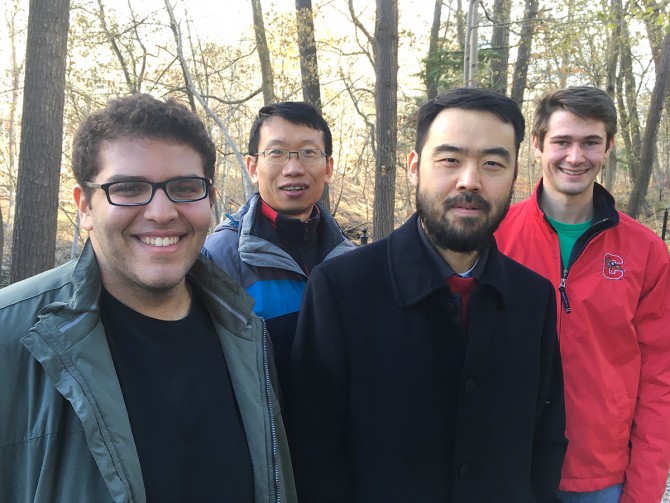On the highway to health: trimming toxins with trees
Cornell engineering students are creating a state-of-the-art computer model to strategically place trees on highways near residential areas to mitigate pollution particles and improve human health.
Doctoral candidates Khaled Hashad and Bo Yang, and undergraduate researcher Dan Shaw ’18 – all working in the Energy and the Environment Research Laboratory of Max Zhang, professor of mechanical engineering – are developing a computational fluid dynamics model for the Green Heart project, a research effort that connects a greener environment to human health. The project is managed by the University of Louisville School of Medicine and funded by the Nature Conservancy. The Cornell team is primarily supported by the National Science Foundation on science-driven green infrastructure designs.
“We will be modeling trees and other vegetation, while exploring different designs and ways to scrub the particle pollution,” said Hashad. “For the next five years, we’ll be examining the space between trees in mitigating pollution from the highway, finding the best species and assembling a model to determine which trees belong where. And then we’ll measure the model’s efficacy.”
Observational opportunity abounds in Louisville, Kentucky, as Interstate 64 slices through the city from east to west, I-65 cuts north-south and I-265 serves as a partial beltway around the city. More than 12,000 trees will be planted annually over the five-year Green Heart Project, increasing vegetation by about 30 percent by 2022, the project’s final year.
In addition to producing carbon dioxide, automobiles and trucks generate particulate matter. For the Green Heart Project, the Cornell students will be studying ultrafine (smaller than 100 nanometers in diameter) and fine particulate matter (smaller than 2.5 microns in diameter, also known as PM2.5), which are so fine they can only be observed under a microscope.
Fine particulate matter pollution – which can easily pass through the nose and throat – can irritate lungs, aggravate chronic lung conditions, impair heart function and increase illness for those who are vulnerable, according to the U.S. Environmental Protection Agency.
The Cornell team will examine leaf density, turbulence and how trees affect the flow of air from highways to neighborhoods, and determine if trees grown in a streamline shape will reduce pollution. Other parts of the project will track 700 Louisville residents to see how greening the highways can improve human health.
“It is a coupling of aerosol dynamics, chemistry along with fluid effects,” said Shaw. “Between the cars and the road, and the road and the surroundings, it is possible to alter the fate and transport of the pollutants and mitigate the health risks.”
Highway pollution policies are needed now, but policy change takes a long time. “This work can reduce pollution for the short term,” said Shaw.
Zhang, a fellow at Cornell’s Atkinson Center for a Sustainable Future and the recipient of the 2017 Engaged Scholar Prize, hopes that testing science-driven designs of roadside green infrastructure can help other communities.
“Beyond Louisville, other cities and towns may identify mitigation solutions to their local near-road air pollution problems – this contributes to sustainable community development,” said Zhang. “This model, I believe, could foster interdisciplinary partnerships among different fields – such as air quality and transportation managers, landscapers and urban planners – in solving transportation air quality problems.”
By the end of the fifth year, Hashad expects to have a very good model. “If we succeed in creating the model, we’re going to reduce health costs and improve the health for a lot of people,” he said. “It’s that easy – plant a tree, if you know how to do it properly.”
This article is written by Blaine Friedlander and was originally published in the Cornell Chronicle on

